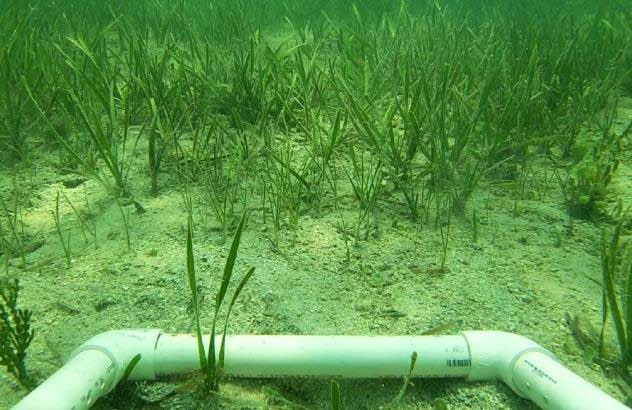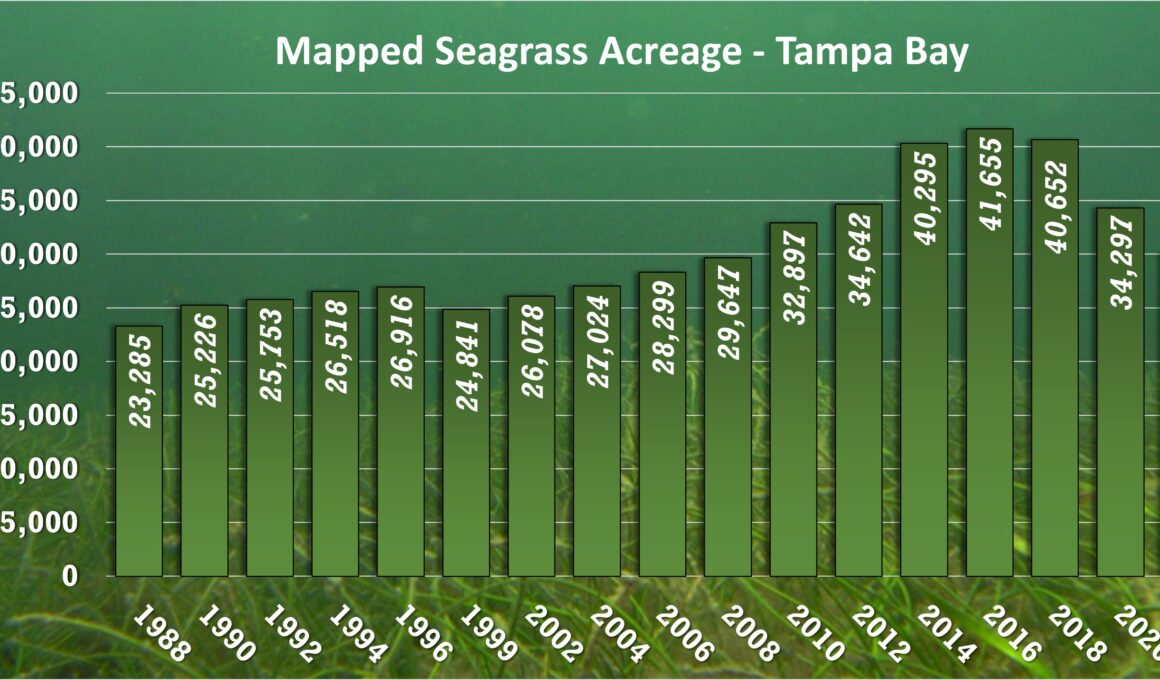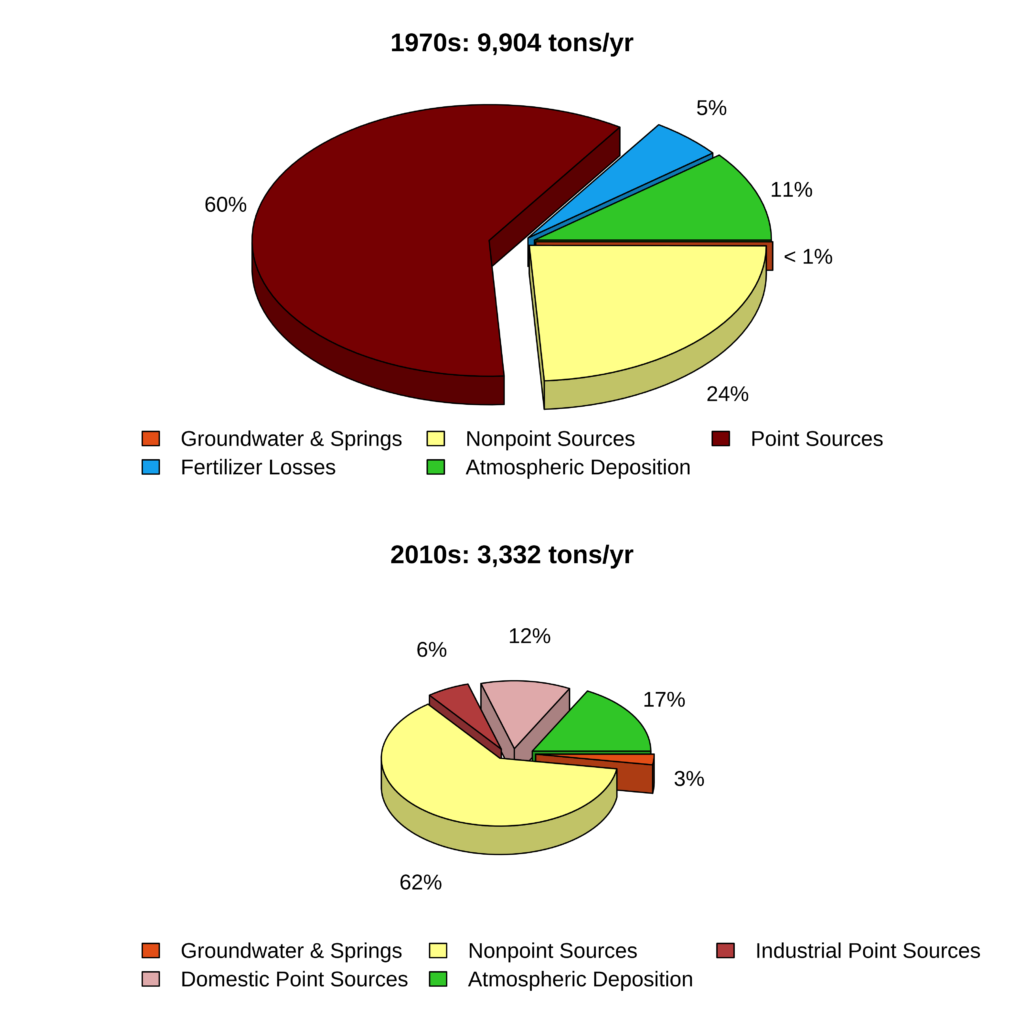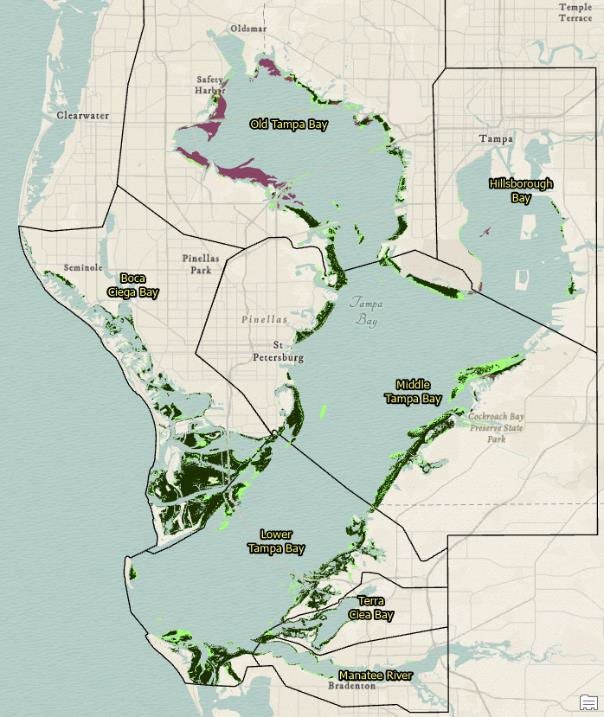The paradigm that made Tampa Bay an international success story for nearly three decades appears to be changing. More than 30% of the bay’s seagrasses have been lost since 2016, with acreage in Old Tampa Bay at the lowest level ever recorded. Throughout the bay, seagrasses declined by 11,599 acres of seagrasses from the high of 41,655 posted in 2016.

Water quality parameters in most of the bay are still meeting targets set in the early 1990s, which were determined with the specific goal of allowing seagrasses to return to areas where they had been present in the 1950s. The exact causes are unknown, but bay managers are calling for a quick response – not a “paralysis of analysis” – before Tampa Bay starts to see losses like those in the Indian River Lagoon.
The original management paradigm called for reducing nutrients that fuel the growth of algae so that light could penetrate to the bottom of the bay where seagrasses grow. That worked until 2014, but a slight decline in 2018 was followed by a 16% loss in 2020 and a 12% decrease in 2022.
“Tampa Bay is a good example of where you’re meeting your criteria for nitrogen, and if you’re just looking at the water column, you should be good to go,” said Chris Anastasiou, the chief water quality scientist leading the bi-annual seagrass surveys at the Surface Water Improvement and Management (SWIM) program of the Southwest Florida Water Management District. “But obviously things are not good, and that leads us to the discussion where the nitrogen is going.”
With water quality goals being met even as seagrasses die off, bay managers will be revisiting those targets, both in terms of water clarity, chlorophyll concentrations, and nitrogen loadings. “We’re looking at the current assimilative capacity of the bay – how much nitrogen can it handle and still allow seagrasses to grow,” said Marcus Beck, program scientist at the Tampa Bay Estuary Program. “Understanding that capacity will be a priority for us.”
Stormwater Takes Center Stage
Tampa Bay’s success has been driven by the Tampa Bay Estuary Program’s (TBEP) “hold the line” commitment to limiting nutrient loadings entering the bay to what was being discharged in the early 1990s, even as the region’s population continued to grow. Initially, those loadings came primarily from point sources, where they could be traced. Working with partners across the watershed, those regulated point source loadings have been significantly reduced and continue to meet targets, Beck said.
While those allocations may need to be revisited, the bigger issue now is stormwater from small, widely distributed sources, which is more difficult to measure and control, Beck said. “If you look at the total nitrogen loadings to Tampa Bay, the contributions from stormwater have increased over time. Increased populations mean more land development and more stress on our stormwater and wastewater infrastructure.”
Over the last decade, nonpoint sources of pollution, such as lawn fertilizers and urban runoff, have contributed over 60% of the nitrogen load to Tampa Bay. TBEP is working with state regulators to develop a comprehensive stormwater plan, but even when it’s complete, it will be expensive to implement. “We need to be heavily investing in stormwater controls, which includes upgrades to aging infrastructure, especially as our population continues to grow.”
A Different Kind of Algal Bloom?

As bay managers reconsider how much nitrogen the bay can assimilate – and how loadings can be limited to meet those new goals – they’re also looking at other factors that may be implicated in the ongoing loss of seagrasses. One of the culprits may be macroalgae, including Caulerpa, a native attached macroalgae that is growing quickly in parts of Tampa Bay, and two species of drift macroalgae that appear to be increasing in the bay.
The original water quality targets set in the 1990s were based on controlling the growth of free-floating microscopic algae that can affect seagrass growth by limiting the light that reaches the bay bottom. Since the macroalgae also consume nitrogen, they may minimize the nutrients available to floating algae, so water quality targets are being met even as seagrasses decline.
“There are a lot of questions about nutrient cycling and I think we need to redo that assessment,” Beck said. “We need to look at questions about water clarity and where the nutrients are going. It’s not paralysis by analysis, but it’s information that hasn’t been updated in a long time and it’s key to seeing where those nutrients are going.”
In Old Tampa Bay, there may be a link between persistent Pyrodinium, a harmful algal species found in the water column, increases in Caulerpa, a green algae that attaches to the bottom, and seagrass loss, Anastasiou said. “In early 2018, we had far more seagrasses than Caulerpa, but after persistent Pyrodinium blooms between 2018 and 2021, we saw major increases in Caulerpa and major losses of seagrass. It’s still only a hypothesis, but there is evidence to suggest a linkage between seagrass loss, Pyrodinium blooms, and Caulerpa.”
Another important class of macroalgae is drift algae. Unlike Caulerpa that attach to the sediment via root-like structures called “hold-fasts,” drift algae, as the name suggests, drift around like undersea tumbleweed. They’re not currently mapped because of their transient nature. However, drift algae have been increasing in abundance across Tampa Bay and other estuaries across Florida and that has had a negative impact on seagrass habitat.
“Mapping an organism that doesn’t stay in one place can be a bear but moving forward it needs to be a part of our monitoring strategy,” Anastasiou said.
Climate Change Also Could Play a Role
Since sunlight is so important, seagrasses in Tampa Bay typically grow in a fringe bordering its shores in water that is less than six feet deep. With warming oceans causing sea level rise, much of the bay is six inches deeper than it was 30 years ago, potentially limiting growth along the edges.
Warmer waters also encourage the growth of algae, particularly when those higher temperatures last later into the year. “The growing season for a lot of the stuff we don’t want to see may have shifted three or four weeks, and that could be enough to shift the competitive edge to some of the algae,” Anastasiou said. “This is an area of research that is happening and needs to continue, especially as the climate continues to warm.”
Maybe a Small Sliver of a Silver Lining?
Seagrasses increased by 8%, or about 1,000 acres in St. Joseph’s Sound and Clearwater Harbor, but those ecological systems more closely resemble the seagrass meadows along Florida’s Springs Coast off Pasco, Hernando, Citrus, and Levy Counties than those found in Tampa Bay, Anastasiou said.
Not Just Tampa Bay
The ominous loss of seagrasses isn’t confined to Tampa Bay. On the east coast, the Indian River Lagoon has lost nearly 90% of its seagrasses in some areas, and manatees that once depended on the seagrasses are now being fed Romaine lettuce to keep them alive during the winter. Restoring the 45-mile-long estuary could cost as much as $5 billion in public and private investments, primarily to limit nutrients flowing into the largely land-locked lagoon.
Seagrass coverage also dropped in estuaries along Florida’s west coast, from Sarasota Bay south to Charlotte Harbor. In Sarasota, a 6% loss between 2020 and 2022 follows a 12% decline between 2018 and 2020. While seagrass loss in Charlotte Harbor was minimal with only a 2% reduction between 2020 and 2022, this still represents an all-time record low in seagrass acreage since mapping began in 1988.
Across the state, estuaries have lost 170 square miles of seagrasses in the last 10 years, said Dave Tomasko, executive director of the Sarasota Bay Estuary Program who has spent most of his career working in the Tampa Bay region. “I think this survey has just proven that we’re not doing enough. We’re not as bad as the Indian River Lagoon, but we’re halfway there. And I’m not sure we should be so confident in our ability to turn this around. We need to take this as a challenge because we don’t know when and where this will end.”
By Vicki Parsons, originally published February 2023


